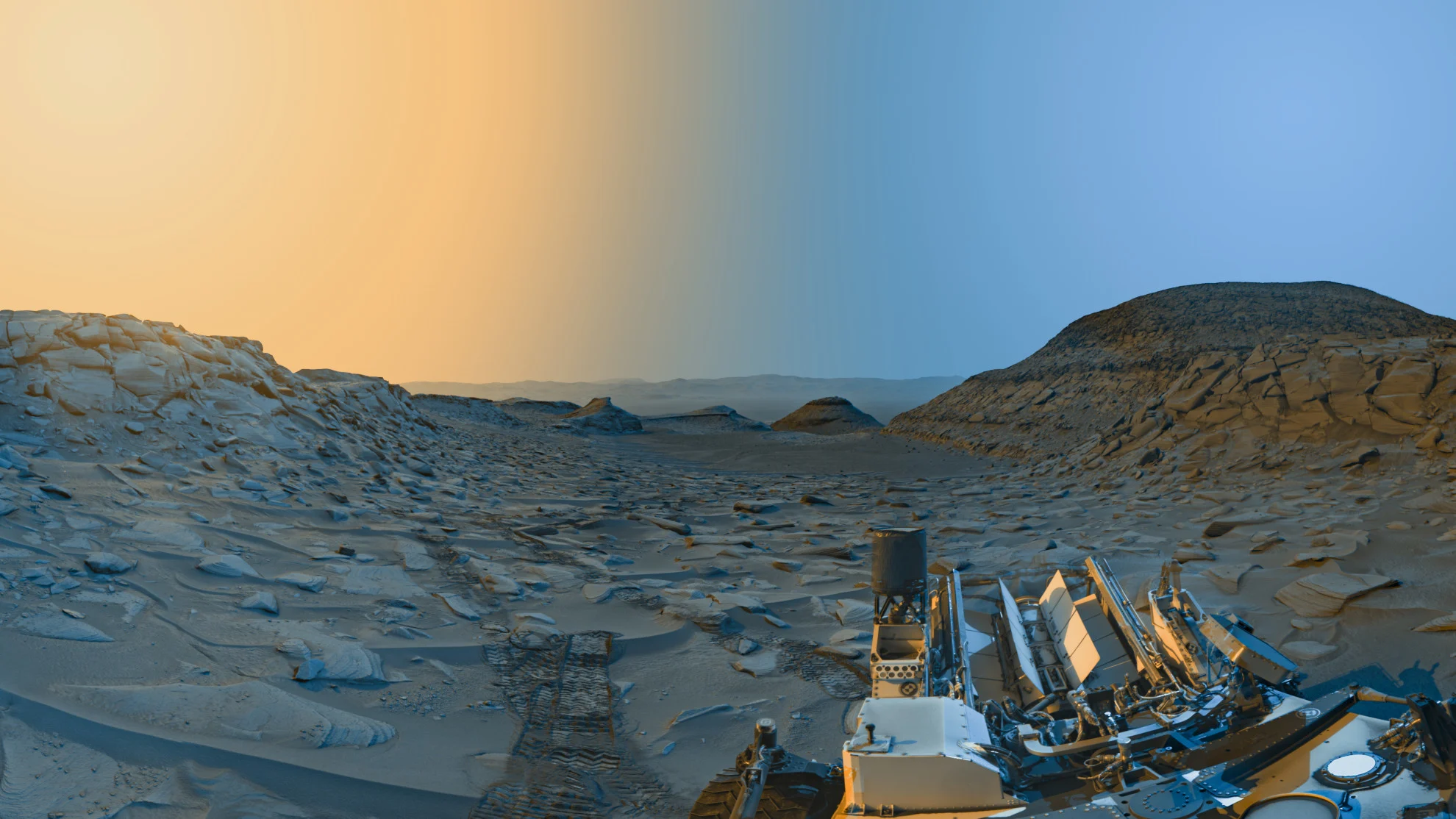
Curiosity rover sends back a marvelous 'postcard' view of Mars
Even on a desolate planet like Mars, timing your scenic photographs just right can result in some beautiful postcard-worthy pictures.
You're in the middle of an impressive hike, and you've just paused for a bit of self-improvement. It's time to immortalize the occasion with a postcard-worthy picture!
That is essentially what the Mars Curiosity rover has just done.
Curiosity is in the middle of a journey up the foothills of Mount Sharp, the 5-kilometre-tall mountain in Gale Crater on Mars. Stopping in early April while NASA sent a major software update to improve its driving ability, the rover snapped two composite images of the "Marker Band Valley" it had just explored.

These two composite images, taken with Curiosity's navigational cameras, capture Marker Band Valley in the distance, the rovers tracks, and the back of the rover itself, during the morning hours (top) and in the afternoon (bottom). Credit: NASA/JPL-Caltech
According to NASA, the "Marker Band" is an unusual winding strip of rock that, from orbit, appeared quite different from the layers and sediments above and below it. When Curiosity reached the band, it found the stones there to be exceptionally hard, but it also discovered some of the strongest evidence for waves and water of its entire mission so far!
READ MORE: NASA's Perseverance rover lost its pet Martian rock
Using the two composite images, the first taken at around 9:20 a.m. and the second at 3:40 p.m., local Mars time, Curiosity engineer Doug Ellison combined them and added colour for "an artistic interpretation" to produce this fantastic postcard view.

Curiosity's postcard of Marker Band Valley, with the bright morning view on the left highlighting the sharp details of the scenery and the darker afternoon view on the right featuring the deepening shadows. Credit: NASA/JPL-Caltech
"Anyone who's been to a national park knows the scene looks different in the morning than it does in the afternoon," saidEllison, who planned the images and processed the final postcard picture from NASA's Jet Propulsion Laboratory, in Pasadena, California.
"Capturing two times of day provides dark shadows because the lighting is coming in from the left and the right, like you might have on a stage," Ellison explained, "but instead of stage lights, we're relying on the Sun."

This version of the new postcard is annotated, pointing out various features of the scenery, including the rim of Gale Crater and a mountain visible far beyond the rim, plus the rover's tracks and parts of the rover visible in the image. Credit: NASA/JPL-Caltech
Remarkably, since it's winter in Gale Crater right now, which is a period when Martian dust is at its lowest concentration in the atmosphere, the rover was able to clearly image very distant parts of the scenery.
This includes the rim of Gale Crater, around 40 kilometres from the rover's current position, and even a distant unnamed mountain peak, located outside the crater, roughly 127 kilometres away!
DON'T MISS: The mystery of our transparent universe has been solved!
As of June 16, 2023, Curiosity has been on Mars for a total of 3,860 Sols (1 Sol = 1 day on Mars). That equates to 10 years, 10 months, and 10 days by Earth's calendar. In that time, the rover travelled a total of just over 30 kilometres while performing important science and returning striking imagery of Gale Crater, an ancient impact site with an immense layered mountain in the middle, which was likely the site of a large lake when Mars was warmer and wetter.
Curiosity's latest software update from NASA had been in the works since 2016 and included roughly 180 changes to the rover's programming. One of the most critical parts of the update was to improve Curiosity's ability to 'think while driving', something that the rover's newer cousin, Perseverance, can do very well.
"This won't let Curiosity drive as quickly as Perseverance, but instead of stopping for a full minute after a drive segment, we're stopping for just a moment or two," Jonathan Denison, Curiosity's engineering operations team chief at JPL, said in a blog post about the update back in April. "Spending less time idling between drive segments also means we use less energy each day. And even though we're almost 11 years old, we're still implementing new ideas to use more of our available energy for science activities."











